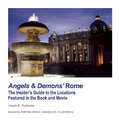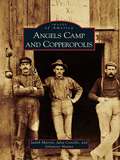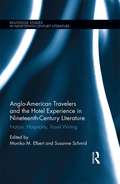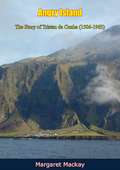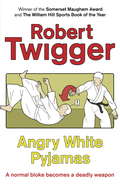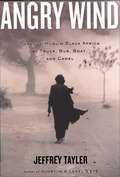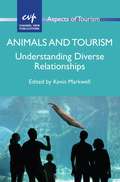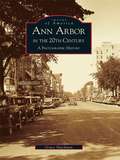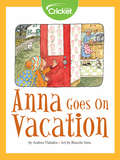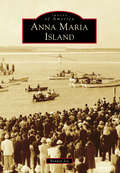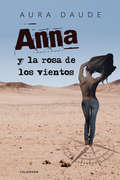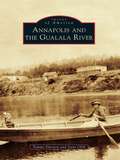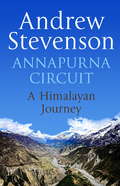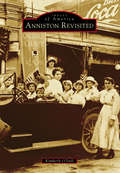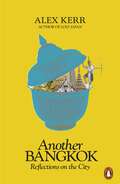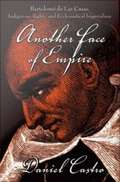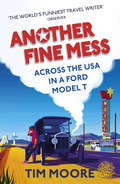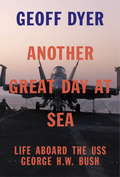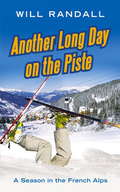- Table View
- List View
Angels & Demons Rome
by Angela K. NickersonRetrace the steps of Robert Langdon, Vittoria Vetra, the Hassassin, and the camerlengo, to find a new and exciting perspective on the city of Rome.
Angels Camp and Copperopolis
by Sal Manna Judith Marvin Julia CostelloThe Angels Camp and Copperopolis regions offer a fascinating chapter in the history of the Mother Lode. Calaveras County's southwest corner has many tales to tell, including one of the earliest settlements of the Native American in California; two of the most famous names in Americana, Mark Twain and Black Bart; and two major events in national history, the Gold Rush and the Civil War. An important Gold Rush town, Angels Camp gained even greater fame through Twain's "The Celebrated Jumping Frog of Calaveras County," which inspired the world-famous Jumping Frog Jubilee. At the same time, Copperopolis became a critical supplier of copper to the Union during the Civil War. Legendary outlaw Black Bart made his first and his last stagecoach holdup here. Ferries and railways served the region that also included the settlements of Hodson, Milton, Felix, Carson Hill, Dogtown, and Lost City.
Anglo-American Travelers and the Hotel Experience in Nineteenth-Century Literature: Nation, Hospitality, Travel Writing (Routledge Studies in Nineteenth Century Literature)
by Susanne Schmid Monika M ElbertThis volume examines the hotel experience of Anglo-American travelers in the nineteenth century from the viewpoint of literary and cultural studies as well as spatiality theory. Focusing on the social and imaginary space of the hotel in fiction, periodicals, diaries, and travel accounts, the essays shed new light on nineteenth-century notions of travel writing. Analyzing the liminal space of the hotel affords a new way of understanding the freedoms and restrictions felt by travelers from different social classes and nations. As an environment that forced travelers to reimagine themselves or their cultural backgrounds, the hotel could provide exhilarating moments of self-discovery or dangerous feelings of alienation. It could prove liberating to the tourist seeking an escape from prescribed gender roles or social class constructs. The book addresses changing notions of nationality, social class, and gender in a variety of expansive or oppressive hotel milieu: in the private space of the hotel room and in the public spaces (foyers, parlors, dining areas). Sections address topics including nationalism and imperialism; the mundane vs. the supernatural; comfort and capitalist excess; assignations, trysts, and memorable encounters in hotels; and women’s travels. The book also offers a brief history of inns and hotels of the time period, emphasizing how hotels play a large role in literary texts, where they frequently reflect order and disorder in a personal and/or national context. This collection will appeal to scholars in literature, travel writing, history, cultural studies, and transnational studies, and to those with interest in travel and tourism, hospitality, and domesticity.
Angry Island: The Story of Tristan da Cunha (1506-1963)
by Margaret MackayTristan da Cunha is both a remote group of volcanic islands in the south Atlantic Ocean and the main island of that group. It is the most remote inhabited archipelago in the world, lying approximately 1,511 miles (2,432 km) off the coast of Cape Town in South Africa, 1,343 miles (2,161 km) from Saint Helena and 2,166 miles (3,486 km) off the coast from the Falkland Islands. The territory consists of the main island, Tristan da Cunha, which has a diameter of roughly 11 km (6.8 mi) and an area of 98 sq km (38 sq mi), the smaller, uninhabited Nightingale Islands, and the wildlife reserves of Inaccessible Island and Gough Island. As of October 2018, the main island has 250 permanent inhabitants who all carry British Overseas Territories citizenship. The other islands are uninhabited, except for the personnel of a weather station on Gough Island.Tristan da Cunha is part of the British Overseas Territory of Saint Helena, Ascension, and Tristan da Cunha. This includes Saint Helena and also near-equatorial Ascension Island, which lies some 1,741 miles (2,802 km) to the north of Tristan. There is no airstrip of any kind on the main island, meaning that the only way of travelling in and out of Tristan is by boat, a six-day trip from South Africa.Angry Island: The Story of Tristan da Cunha (1506-1963) by Margaret Mackay was first published in 1963, the year the Tristanians returned to their island after its volcano erupted in 1961 and forced the evacuation of the entire population to England. As the most isolated inhabited island on Earth, the Tristanians have had to adapt and develop innovative ways in order to survive, and in this book, Mrs. Mackay tells a very detailed history of Tristan da Cunha since its discovery over five hundred years ago, sharing many shipwreck tales and early yet failed attempts to settle the island.A gripping read!
Angry White Pyjamas
by Robert TwiggerA brilliant and captivating insight into the bizarre nature of contemporary Japan.Adrift in Tokyo, teaching giggling Japanese highschool girls how to pronounce Tennyson correctly, Robert Twigger came to a revelation about himself: he'd never been fit. In a bid to escape the cockroach infestation and sweaty squalor of a cramped apartment in Fuji Heights, Twigger sets out to cleanse his body and his mind. Not knowing his fist from his elbow the author is sucked into the world of Japanese martial arts, and the brutally demanding course of budo training taken by the Tokyo Riot Police, where any ascetic motivation soon comes up against blood-stained dogis and fractured collarbones.In Angry White Pyjamas Robert Twigger skilfully blends the ancient with the modern - the ultra-traditionalism, ritual and violence of the dojo (training academy) with the shopping malls, nightclubs and scenes of everyday Tokyo life in the twenty-first century - to provide an entertaining and captivating glimpse of contemporary Japan.
Angry White Pyjamas
by Robert TwiggerA brilliant and captivating insight into the bizarre nature of contemporary Japan.Adrift in Tokyo, teaching giggling Japanese highschool girls how to pronounce Tennyson correctly, Robert Twigger came to a revelation about himself: he'd never been fit. In a bid to escape the cockroach infestation and sweaty squalor of a cramped apartment in Fuji Heights, Twigger sets out to cleanse his body and his mind. Not knowing his fist from his elbow the author is sucked into the world of Japanese martial arts, and the brutally demanding course of budo training taken by the Tokyo Riot Police, where any ascetic motivation soon comes up against blood-stained dogis and fractured collarbones.In Angry White Pyjamas Robert Twigger skilfully blends the ancient with the modern - the ultra-traditionalism, ritual and violence of the dojo (training academy) with the shopping malls, nightclubs and scenes of everyday Tokyo life in the twenty-first century - to provide an entertaining and captivating glimpse of contemporary Japan.
Angry Wind: Through Muslim Black Africa by Truck, Bus, Boat, and Camel
by Jeffrey TaylerTraveling by bus, airplane, in the back of trucks and on camel, the author travels through the most war-torn parts of Africa. The author answers such crucial questions as 'What do Muslims think of President Bush?' and 'Do all Muslims and Africans hate Americans?' Tayler travels through some of the most remote and war-torn parts of Africa to find out. From the corrupt dealings in Nigeria to the war-torn areas of Mali and Chad, the author shows us the beautiful humanity and heart-breaking inhumanity of man.
Angry Wind: Through Muslim Black Africa by Truck, Bus, Boat, and Camel
by Jeffrey TaylerHailed by Bill Bryson and the New York Times Book Review as a rising star among travel writers, Jeffrey Tayler penetrates one of the most isolated, forbidding regions on earth--the Sahel. This lower expanse of the Sahara, which marks the southern limit of Islam&’s reach in West and Central Africa, boasts such mythologized places as Mopti and Timbuktu, as well as Africa&’s poorest countries, Chad and Niger. In parts of the Sahel, hard-line Sharia law rules and slaves are still traded. Racked by lethal harmattan winds, chronic civil wars, and grim Islamic fundamentalism, it is not the ideal place for a traveler with a U.S. passport. Tayler finds genuine danger in many guises, from drunken soldiers to a thieving teenage mob. But he also encounters patience and generosity of a sort found only in Africa. Traveling overland by the same rickety means used by the local people--tottering, overfilled buses, bush taxis with holes in the floor, disgruntled camels--he uses his fluency in French and Arabic (the region&’s lingua francas) to connect with them. Tayler is able to illuminate the roiling, enigmatic cultures of the Sahel as no other Western writer could.
Animals and Tourism
by Kevin MarkwellThis book critically examines the many ways in which tourism and animals intersect, whether as tourist attractions, wildlife conservation tools, as travel companions or as meat to be eaten. It aims to make a meaningful contribution to the growing body of knowledge concerning the relationships between animals, tourists and the tourism industry. The chapters are organised into three themes: ethics and welfare; conflict, contradiction and contestation; and shifting relationships. Theoretically informed and empirically rich, the chapters examine topics such as whale watching, animal performances, the objectification and commodification of animals and stakeholder conflict among a range of others. It is hoped that the book will help to highlight key research questions and stimulate other researchers and students to reflect critically on the place of animals within tourism spaces, experiences, practices and structures.
Animals, Food, and Tourism (Routledge Research in the Ethics of Tourism Series)
by Carol KlineFood is routinely given attention in tourism research as a motivator of travel. Regardless of whether tourists travel with a primary motivation for experiencing local food, eating is required during their trip. This book encompasses an interdisciplinary discussion of animals as a source of food within the context of tourism. Themes include the raising, harvesting, and processing of farm animals for food; considerations in marketing animals as food; and the link between consuming animals and current environmental concerns. Ethical issues are addressed in social, economic, environmental, and political terms. The chapters are grounded in ethics-related theories and frameworks including critical theory, ecofeminism, gustatory ethics, environmental ethics, ethics within a political economy context, cultural relativism, market construction paradigm, ethical resistance, and the Global Sustainable Tourism Criteria. Several chapters explore contradicting and paradoxical ethical perspectives, whether those contradictions exist between government and private sector, between tourism and other industries, or whether they lie within ourselves. Like the authors in Tourism Experiences & Animal Consumption: Contested Values, Morality, & Ethics, the authors in this book wrestle with a range of issues such as animal sentience, the environmental consequences of animals as food, viewing animals solely as a extractive resource for human will, as well as the artificial cultural distortion of animals as food for tourism marketing purposes. This book will appeal to tourism academics and graduate students as a reference for their own research or as supplementary material for courses focused on ethics within tourism.
Ann Arbor in the 19th Century: A Photographic History
by Grace ShackmanAnn Arbor has never been a typical college town, typical industrial town, or typical agricultural center. The city was founded in 1824 by John Allen and Elisha Rumsey. Settlers from the Eastern U.S. of British origin were soon followed by Germans, who brought with them many practical skills. With the opening of the University of Michigan campus in 1841, still more people came from across the country to teach and learn. Ann Arbor in the 19th Century: A Photographic History, details the growth of the city, when residents built houses and businesses, organized a government, and established churches, schools, a university, and newspapers, in over 190 photographs. Early residents would recognize the photograph of Okemos, nephew of Pontiac, Chief of the Ottawa, who made regular visits to Ann Arbor, before the Native Americans were banished to Kansas by the federal government. Another fascinating photo shows Henry Otto's Band, whose family was responsible for much of the music at official events. However, much of 19th century Ann Arbor would still be recognizable to today's residents.
Anna Goes on Vacation
by Andrea VlahakisAnna packed her pajamas and slippers. Her toothbrush was in her backpack, too. And her favorite book. She is staying with her grandmother in the barn across the driveway. But that doesn't mean she still doesn't miss her father!
Anna Maria Island (Images of America)
by Bonner JoyAnna Maria Island was once inhabited by Native Americans, but as the beauty became known to its first homesteader, George L. Bean, the island's destiny was to be a beacon to paradise. In spite of mangrove forests and throngs of mosquitoes, people came by boat to enjoy the white sand beaches and the turquoise waters of the Gulf of Mexico, with their cool onshore breezes and blazing sunsets. The Islander newspaper of the 1950s heralded, "Where life is good and the fishing is great." Anglers came from afar to test their skills against tarpon, the world's greatest game fish, and to hunt goliath grouper in the depths of Tampa Bay. Two modern bridges connected the island to the mainland in 1957, and with that the seven-mile-long island was on its way to becoming the jewel of Manatee County.
Anna y la rosa de los vientos
by Aura DaudeY todo parecía ser un típico viaje de turistas. Real, casi ficticia. Un solo día, un solo encuentro, la interacción entre dos desconocidos hará virar los acontecimientos. «Viaje a través de los meridianos», Historia del Arte, fotos prohibidas, expolio. No falto de ensayo, ¿podría asentarse una mina de oro en un conocido enclave arqueológico? Anna, un país y un final que te devuelven a medio relato.
Annapolis and the Gualala River (Images of America)
by Tammy Durston Steve OliffAnnapolis--a hidden jewel of a community--is tucked into the timber-filled ridges above the jagged northern Sonoma coastline. Undeterred by the steep, mountainous terrain and rugged living, early settlers were first lured to the area by the timber. They quickly discovered Annapolis had perfect weather for apple farming. At the beginning of the 20th century, almost every farm had apples, and apple dryers dotted the hills. The wild Gualala River, known for Coho salmon and steelhead trout, is 32 miles long and flows through the Annapolis area before meeting the Pacific Ocean. Early Native American Pomo tribes settled along this important river, which eventually served as a boundary between Sonoma and Mendocino Counties.
Annapurna Circuit: Himalayan Journey
by Andrew StevensonMany disenchanted Westerners have gone to the Himalayas in search of renewal, but no one has written about the experience as perceptively and personally as Andrew Stevenson in Annapurna Circuit. A traveller all his life, Stevenson responds to people and places with an openness unique to the cultural nomad - his portraits of the men, women and children of the Annapurnas, and the fellow-backpackers from all over the world who intermittently shared his journey, are a delight; his descriptions of the landscape, and the physical hardships of the trek are enthralling. But like every travel book of real quality, this is also the result of a spiritual journey. A richly rewarding read on every level, Annapurna Circuit is a modern travel classic in the tradition of Peter Matthiesson's Snow Leopard and Andrew Harvey's Journey to Ladakh.
Annapurna Circuit: Himalayan Journey
by Andrew StevensonMany disenchanted Westerners have gone to the Himalayas in search of renewal, but no one has written about the experience as perceptively and personally as Andrew Stevenson in Annapurna Circuit.A traveller all his life, Stevenson responds to people and places with an openness unique to the cultural nomad - his portraits of the men, women and children of the Annapurnas, and the fellow-backpackers from all over the world who intermittently shared his journey, are a delight; his descriptions of the landscape, and the physical hardships of the trek are enthralling. But like every travel book of real quality, this is also the result of a spiritual journey. A richly rewarding read on every level, Annapurna Circuit is a modern travel classic in the tradition of Peter Matthiesson's Snow Leopard and Andrew Harvey's Journey to Ladakh.
Anniston Revisited
by Kimberly O’dellNestled in the Piedmont region of the Appalachian Mountains, the small farming community of Pine Ankle was established in the 1830s on the former lands of the Creek Nation. In 1872, industrialists Samuel Noble and Daniel Tyler purchased the land for their Woodstock Iron Company, and in 1883 the town was opened to the public as Annie's Town. It grew rapidly, and by the early 20th century Anniston was not only the seat of Calhoun County, but also home to numerous textile and iron industries as well as a thriving military complex. The vintage photographs in Images of America: Anniston Revisited showcase the daily lives of Annistonians and Fort McClellan soldiers during a time when Noble Street was a bustling urban center. Anniston's homes, schools, and community centers are featured, along with the expanded downtown area and Fort McClellan, to paint a vivid portrait of "The Model City."
Another Bangkok: Reflections on the City
by Alex KerrFrom the author of Another Kyoto and Lost Japan, a rich, personal exploration of the culture and history of Bangkok, and an essential guide for anyone visiting the cityAlex Kerr has spent over thirty years of his life living in Bangkok. As with his bestselling books on Japan, this evocative personal meditation explores the city's secret corners. Here is the huge, traffic-choked metropolis of concrete high-rises, slums and sky trains; but also a place of peace and grace. Looking afresh at everything from ceramics to Thai dance, flower patterns to old houses, Kerr reveals one of Asia's most kaleidoscopically complex cities. Another Bangkok will delight both those who think they know the city well and those visiting for the first time.
Another Face of Empire: Bartolomé de Las Casas, Indigenous Rights, and Ecclesiastical Imperialism
by Daniel CastroThe Spanish cleric Bartolom de Las Casas is a key figure in the history of Spain's conquest of the Americas. Las Casas condemned the torture and murder of natives by the conquistadores in reports to the Spanish royal court and in tracts such as A Short Account of the Destruction of the Indies (1552). For his unrelenting denunciation of the colonialists' atrocities, Las Casas has been revered as a noble protector of the Indians and as a pioneering anti-imperialist. He has become a larger-than-life figure invoked by generations of anticolonialists in Europe and Latin America. Separating historical reality from myth, Daniel Castro provides a nuanced, revisionist assessment of the friar's career, writings, and political activities. Castro argues that Las Casas was very much an imperialist. Intent on converting the Indians to Christianity, the religion of the colonizers, Las Casas simply offered the natives another face of empire: a paternalistic, ecclesiastical imperialism. Castro contends that while the friar was a skilled political manipulator, influential at what was arguably the world's most powerful sixteenth-century imperial court, his advocacy on behalf of the natives had little impact on their lives. Analyzing Las Casas's extensive writings, Castro points out that in his many years in the Americas, Las Casas spent very little time among the indigenous people he professed to love, and he made virtually no effort to learn their languages. He saw himself as an emissary from a superior culture with a divine mandate to impose a set of ideas and beliefs on the colonized. He differed from his compatriots primarily in his antipathy to violence as the means for achieving conversion.
Another Fine Mess
by Tim MooreTim Moore - indefatigable travelling everyman – switches two wheels for four as he journeys across Trumpland in an original Model T Ford.‘Alarmingly full of incident, very funny – even mildly transformative’ Daily MailLacking even the most basic mechanical knowhow, Tim Moore sets out to cross Trumpland USA in an original Model T Ford. Armed only with a fan belt made of cotton, wooden wheels and a trunkload of ‘wise-ass Limey liberal gumption’, his route takes him exclusively through Donald-voting counties, meeting the everyday folks who voted red along the way.He meets a people defined by extraordinary generosity, willing to shift heaven and earth to keep him on the road. And yet, this is clearly a nation in conflict with itself: citizens ‘tooling up’ in reaction to ever-increasing security fears; a healthcare system creaking to support sugar-loaded soda lovers; a disintegrating rust belt all but forgotten by the warring media and political classes.With his trademark blend of slapstick humour, affable insight and butt-clenching peril, Tim Moore invites us on an unforgettable road trip through America. Buckle up!
Another Great Day at Sea: Life Aboard the USS George H.W. Bush
by Geoff DyerFrom a writer "whose genre-jumping refusal to be pinned down [makes him] an exemplar of our era" (NPR), a new book that confirms his power to astound readers. As a child Geoff Dyer spent long hours making and blotchily painting model fighter planes. So the adult Dyer jumped at the chance of a residency aboard an aircraft carrier. Another Great Day at Sea chronicles Dyer's experiences on the USS George H.W. Bush as he navigates the routines and protocols of "carrier-world," from the elaborate choreography of the flight deck through miles of walkways and hatches to kitchens serving meals for a crew of five thousand to the deafening complexity of catapult and arresting gear. Meeting the Captain, the F-18 pilots and the dentists, experiencing everything from a man-overboard alert to the Steel Beach Party, Dyer guides us through the most AIE (acronym intensive environment) imaginable. A lanky Englishman (could he really be both the tallest and the oldest person on the ship?) in a deeply American world, with its constant exhortations to improve, to do better, Dyer brilliantly records the daily life on board the ship, revealing it to be a prism for understanding a society where discipline and conformity, dedication and optimism, become forms of self-expression. In the process it becomes clear why Geoff Dyer has been widely praised as one of the most original--and funniest--voices in literature. Another Great Day at Sea is the definitive work of an author whose books defy definition.From the Hardcover edition.
Another Kyoto
by Alex Kerr Kathy Arlyn SokolAnother Kyoto is an insider's meditation on the hidden wonders of Japan's most enigmatic city. Drawing on decades living in Kyoto, and on lore gleaned from artists, Zen monks and Shinto priests, Alex Kerr illuminates the simplest things - a temple gate, a wall, a sliding door - in a new way. 'A rich book of intimate proportions ... In Kyoto, facts and meaning are often hidden in plain sight. Kerr's gift is to make us stop and cast our eyes upward to a temple plaque, or to squint into the gloom of an abbot's chamber' Japan Times'Kerr and Sokol have performed a minor miracle by presenting that which is present in Kyoto as that which we have yet to see. I know that I will never pass a wall, or tread a floor, or sit on tatami the same way again' Kyoto Journal
Another Long Day On The Piste: A Season in the French Alps
by Will RandallWriter, adventurer, ex-teacher and veteran of umpteen travel disasters, Will Randall has fallen off donkeys in Spain and out of canoes in the Solomon Islands, but none of this has prepared him for a disastrous season as a ski-bum with a posse of raucous, hard-drinking ex-students.Dismally unfashionable and hopeless at skiing, Randal finds that his stay in the charming Alpine backwater of mont St Bernard brings a whole host of new opportunities for domestic catastrophe, romantic rejection and public humiliation, including a stint as a chalet girl and an encounter with a Russian oligarch and his hair-raising entourage.Wry, self-deprecating and deliriously funny, ANOTHER LONG DAY ON THE PISTE is a rollercoaster of a travel adventure and essential apres-ski reading.
Another Long Day On The Piste: A Season in the French Alps
by Will RandallWriter, adventurer, ex-teacher and veteran of umpteen travel disasters, Will Randall has fallen off donkeys in Spain and out of canoes in the Solomon Islands, but none of this has prepared him for a disastrous season as a ski-bum with a posse of raucous, hard-drinking ex-students.Dismally unfashionable and hopeless at skiing, Randal finds that his stay in the charming Alpine backwater of mont St Bernard brings a whole host of new opportunities for domestic catastrophe, romantic rejection and public humiliation, including a stint as a chalet girl and an encounter with a Russian oligarch and his hair-raising entourage.Wry, self-deprecating and deliriously funny, ANOTHER LONG DAY ON THE PISTE is a rollercoaster of a travel adventure and essential apres-ski reading.
